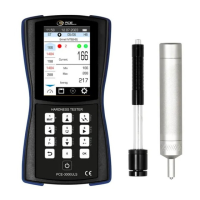14
If the surface roughness of the product is higher than specified, the measurements must
be additionally guided by paragraph 1.11 "Work on products with high roughness".
The minimum radius of curvature of the convex controlled surface is 18 mm /0.7" (for
probes D, and E). For the UCI probe - 4 mm / 0.15".
The minimum radius of curvature of the concave controlled surface is 200 mm/ 7.9"
(with the support washer removed, for probes D, and E). For UCI probe - 6 mm/0.23".
To ensure the positioning of the probe on concave controlled surfaces, it is possible to
use specialized nozzles made to order.
Minimum diameter of the platform for measuring the hardness on the surface of the
controlled product (for installation of the probe).
Probes D, E - 21 mm/ 0.82". (with removed support washer - 6 mm/0.23".).
G probes - 29 mm/1.14". (with removed support washer - 7 mm/0.27".).
The surface of the inspected product must be dry, free of scale, rust, dust, dirt and
degreased.
In case of deviation of material properties of the controlled product from carbon
structural steels (heat-resistant, corrosion-resistant, stainless, etc. steels, non-ferrous metals,
and alloys, etc.), the measurements must be additionally guided by the requirements of 1.8
"Work with products that differ from carbon structural steel".
1.8 Measurement of specimens that differ in properties from carbon steel
The hardness tester's operation principle is based on a dynamic (shock) method of
hardness control. Unlike static hardness testers (benchtop hardness testers), the measurement
results are influenced not only by the properties of the metal during plastic deformation but
also by other physical and mechanical properties. Mostly - the modulus of elasticity of the
controlled metal (Young's modulus). The additional error that arises entails the need to adjust
the device (additional calibration or programming of the additional scale) to work with
materials that have a modulus of elasticity other than the modulus of elasticity of carbon
structural steels.
To determine the presence of additional error, it is necessary to compare the results of
measurements with a hardness tester with the results of measurements with a static principle
device.

